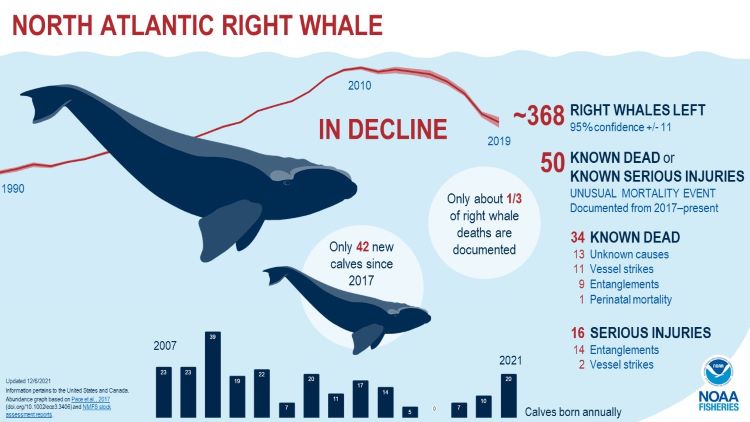Saving an Endangered Species and Iconic Fishery
The U.S. Coast Guard cutter Escanaba was transiting through Cape Cod Bay, seemingly alone, on a calm and cloudy day in late summer 2011. It was mid-day when a dark head with the distinguishing rough white patches of the North Atlantic right whale broke the surface not far from the 270-ft vessel. Then another whale appeared with a quick spout of water from its blowhole followed by a broad, deeply notched tail flicking the water. Not long after crew members had spotted the first two did more arrive, their dark, stout bodies breaching the water, says U.S. Coast Guard Lieutenant Commander Lennie Day. It was his first experience with North Atlantic right whales, and it was a bit disconcerting.
“There were so many around us … it was uncomfortable,” he says. “For us to protect them, we secured our engines completely and drifted, turning on the engine only as needed to stay away to make sure they were safe and that we were safe.”
Protecting right whales can prove challenging at times, he says, because the animals are curious creatures, and Cape Cod Bay, the southernmost region of the Gulf of Maine, is a known feeding ground.
“If they’re in the area, they will actually come up around the ship … [they] don’t see you as a threat.”
Day has witnessed many types of marine life interactions on the water since joining the Coast Guard in 2005, working in both the Pacific and Atlantic oceans. But unlike species that spend time offshore, North Atlantic right whales hug the seaboard as they migrate between Florida and Canada. This, combined with the whales’ slow speed (averaging 6 mph) and their close proximity to human activity, makes them more vulnerable to ship strikes than other species.
“There’s no way you’re going to hit an orca with a boat. That’s just not going to happen, ever. With right whales, their curiosity, I think, causes the threat to their mortality because they’re trying to identify what things are,” says Day, who describes feeling a deep sense of reverence when he first encountered these whales that day on Cape Cod Bay.
“You know there aren’t many of them left, and you just don’t know how long [the species is] going to last.”
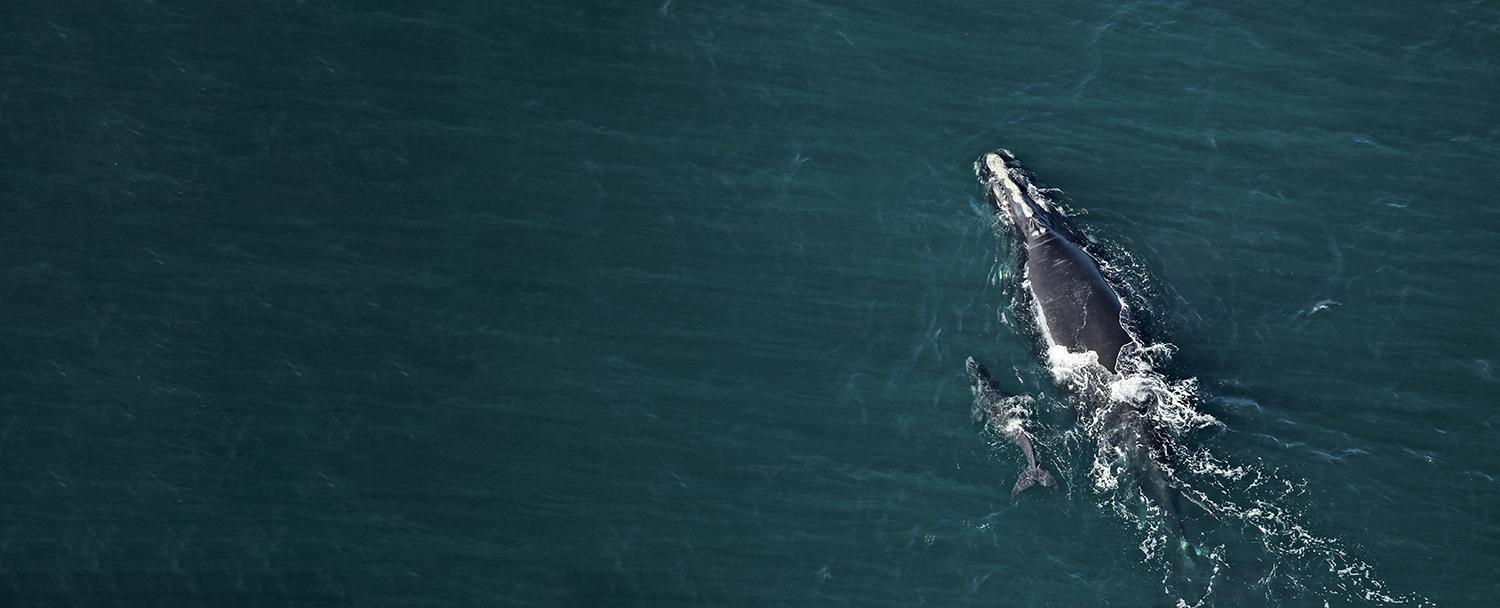
Right whale mother and calf
Photograph courtesy of Florida Fish and Wildlife Conservation Commission
“I understood it was a threatened creature that I needed to preserve in some way … You’re witnessing Earth’s history, and part of that reverence is because you know there aren’t many of them left, and you just don’t know how long [the species is] going to last.”
Right whales can grow to over 60 feet long and weigh up to 300,000 lbs. Their immense body mass makes them significantly heavier than humpback, sperm, and fin whales—ranking them only second behind blue whales—so it’s no small feat for such large whales to leap out of the water in one of the most energy-expensive moves found in nature. Waters from Florida to the Bay of Fundy serve as a major feeding, calving, and migration corridor for North Atlantic right whales. These whales were deemed the “right” whale to hunt by early whalers for their oil and baleen because of their slow mobility, docile nature, and habit of feeding at the surface. By early 1900s, their numbers had been reduced so much that they were no longer economically viable to target. When the species was protected from international whaling in 1935, it was estimated that fewer than 100 individuals were left.
Today, the North Atlantic right whale is still one of the most critically endangered species in the world with fewer than 350 individuals, nearly a quarter of which are reproductively active females, according to the National Oceanic and Atmospheric Administration (NOAA). Despite protection under both the Marine Mammal Protection Act and the Endangered Species Act, their numbers have dropped by 30% in the past decade. And because of their long gestation period and low birth rates in recent years, a loss of even a single individual is a blow to recovery efforts and brings the species closer to extinction.
“One of the major sources of human-caused mortality for right whales is getting run over by ships. The other is getting tangled up in fishing gear,” says Robert Kenney, emeritus marine research scientist at the University of Rhode Island’s Graduate School of Oceanography and one of the co-founders of the North Atlantic Right Whale Consortium—an international organization dedicated to the conservation and recovery of the species.
In addition to lethal ship strikes, right whales are vulnerable to becoming entangled in fishing gear—specifically lobster/crab traps and gillnets—thatcan cause serious injury and impede their ability to swim, eat, and reproduce. These incidents, along with changes in their primary food sources (copepodsand krill) due to climate change, have also forced whales to travel farther for food and closer to shipping lanes, causing them to be thinner, unhealthier, and more vulnerable.
This multitude of stresses has fundamentally changed the whales’ morphology. A North Atlantic right whale born today, according to a study published in the journal Current Biology, is expected to be one to three meters shorter than a whale born in 1980.
“Whales that can’t find enough food and live stressful lives … aren’t going to grow well,” says Michael Moore, a marine scientist from Woods Hole Oceanographic Institute (WHOI). And if these whales are less healthy, they’re less likely to calf, further contributing to a dwindling population.
“We have a moral duty to not allow them to go extinct because of us. They have as much right to exist as any animal,” says Kenney.
SLOW DOWN
To reduce collisions with ships, the National Marine Fisheries Service (NMFS) established 10 seasonal management areas where whales are known to be that prohibit ships 65 feet and longer from traveling faster than 10 knots. Dynamic management areas were also established as voluntary zones, which recommend, but do not require, that all vessels stay below 10 knots when there are sightings of whales. Speed restrictions, if complied with, have been found to reduce a whale’s risk of death from collision by 80% to 90%.
We have a moral duty to not allow them to go extinct because of us. They have as much right to exist as any animal.
One of Day’s jobs is to assist NOAA in enforcing those regulations for the U.S. Coast Guard District 1, which extends from New York to Maine.
“If there is a migration [or congregation] of whales, noaa will put out an area where they want us to enforce speed restrictions,” he says. “We can enforce where we have our stations, or if it’s a larger boat with an AIS [automated identification system] that we can track. With our smaller boat stations, or if a cutter is out, we can slow vessels down by communicating on radio.”
Fines for violating speed restrictions can be extensive (ranging from several thousand up to $50,000 for multiple infractions) but are very rarely issued, according to Day.
“There’s not a lot of commercial traffic through Cape Cod Bay that’s going too fast or doesn’t understand. Boats I see going fast are usually smaller boats, not large commercial vessels.”
But smaller boats can still cause serious harm, according to a recent study from Oceana, an ocean conservation organization. The report noted that a right whale calf died early last year from propeller wounds, broken ribs and a fractured skull following a collision with a 54-foot recreational fishing vessel. Analysis of vessel compliance with speed restrictions between 2017 and 2020 found that noncompliance in voluntary zones has climbed in recent years. Over 70% of ships traveling through southern New England voluntary zones were found traveling above the 10-knot speed limit.
While Oceana’s report highlights a potential concerning trend, compliance with speeding restrictions has proven effective in the past, making a case for enforcement assistance and boater education. But as commercial fishing increases in areas where whales forage, scientists are finding that entanglements are taking a toll not only on the overall numbers, but also on the animal’s wellbeing.
ENTANGLED
Moore, a veterinarian and director of the WHOI Marine Mammal Center, is one of the few experts called to respond to whale strandings and entanglements along the East Coast. He says that in 20 years of performing hundreds of necropsies on diverse marine mammals, he’s found that lethally entangled right whales have taken six months, on average, to succumb to their wounds, which “range from lacerations into the blubber down to the muscle, or around bony structures such as the upper jaw and flipper, or the peduncle of the tail.”
“As a veterinarian, it’s the most horrendous case of drawn-out trauma I’ve ever witnessed,” he says. “I’m not saying it’s intentional; it is something that’s out of sight, out of mind for the consumer and largely to the industries involved as well because they don’t see all of this.”
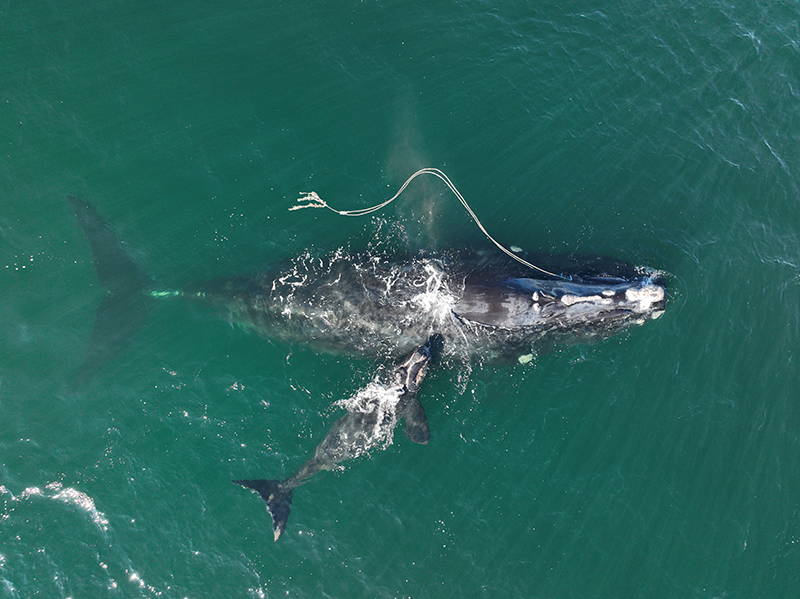
Fishing gear, such as gillnets or lobster and crab traps that have vertical lines of ropes extending from the seafloor to surface buoys, have been identified as the primary cause of death for over half of North Atlantic right whales that often drown or die from starvation or injuries.
New England Aquarium scientists have estimated that 85% of right whales have been entangled at least once, and 60% have been entangled multiple times based on scars observed on their bodies. This comes with a physiological cost.
In 2018, a male right whale named Ruffian was seen wrapped in nearly 500 feet of rope and dragging a 134-pound snow crab trap all the way from Canada to Florida. Scientists calculated that the lines wrapped around a whale’s fins and body can increase drag by 160%, and that towing traps could more than double the load. They estimated that to swim with the extra drag and weight, Ruffian had to burn an extra 27,000 calories a day, explaining why he appeared significantly thinner than a typical right whale.
“The veterinary piece of my brain has been distressed for a long time about this particular story … it’s extremely depressing to be seemingly powerless to do anything for animals I regard as my clients, my patients,” says Moore.
Response teams that are part of the Center for Coastal Studies’ (CCS) Disentanglement Network in Provincetown, which incorporates both NMFS and the Canadian Division of Fisheries and Oceans, as well as both countries’ Coast Guards, have the difficult and dangerous task of trying to remove lines on a live whale.
David Morin, large whale disentanglement coordinator for NMFS, worked as a disentangler for CCS for seven years. One of the worst cases he recorded during that time was an entangled humpback whale. He pulls up a video taken from an underwater camera, providing a clear profile of what appears to be a normal and healthy whale swimming in the ocean until the tail comes into view. It’s stark white, beginning where a fishing line has wrapped around it.
“The entanglement is so bad it basically cut off all circulation to the fluke,” says Morin. “That part of the body essentially died and is just rotting off.”
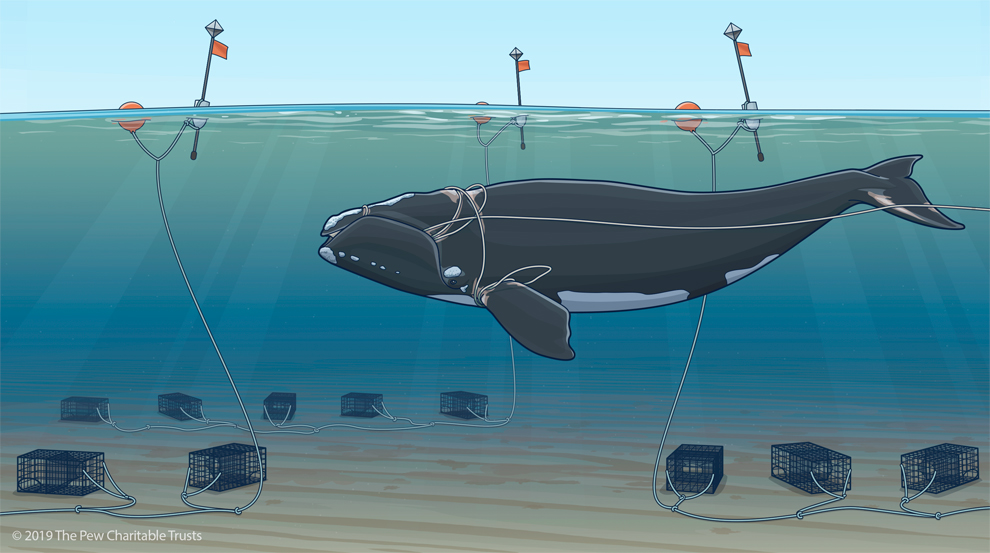
The primary cause of death for North Atlantic right whales is entanglement in vertical ropes that run between lobster and crab traps on the seafloor and buoys on the surface. Ropes can wrap around whales’ bodies, flippers, flukes, or mouths. Graphic by Pew Charitable Trusts.
NO CLEAR PATH
To address the issue of entanglements in fishing gear, NMFS issued updated regulations earlier this year that require modifications of weak ropes, which are intended to break when a whale encounters them. The regulations also include two new seasonal closures—one in the Gulf of Maine from October to January and one south of Nantucket from February to April—which would only allow the use of “ropeless” gear.
These changes come on the heels of a lawsuit, Center for Biological Diversity v. Ross, in which a federal court found NMFS in violation of the Endangered Species Act and the Marine Mammal Protection Act when it authorized the American lobster fishery in 2014, according to a report by the Marine Affairs Institute at Roger Williams University School of Law.
The lawsuit was filed in 2018 after an “unusual mortality event” resulted in the death of 20 right whales. In 2020, the court found that NMFS did not include an incidental take statement despite finding that the lobster fishery. had the potential to harm endangered right whales at more than three times the rate at which the species could sustain itself. Incidental take statements provide estimates of the harm, harassment, or killing of a threatened or endangered species.
The root of the problem, Kenney notes, is embedded in the structure of an agency that is at odds with itself, tasked with ensuring “productive and sustainable” commercial fisheries while also safeguarding endangered or protected species.
A closure each fall is a four-month ban on the use of traditional lobster gear in nearly 1,000 square miles of water off the coast of Maine—impacting prime offshore fishing grounds for a $485 million industry, according to Maine’s Department of Marine Resources. But before the closures could be enforced, a U.S. District Court issued a temporary injunction, siding with the Maine Lobstering Union’s argument that there was insufficient scientific evidence to prove that whales are present in the restricted area and impacted by fishing gear. That injunction was then reversed on appeal, reinstating the ban.
“It only takes one or two right whales to have a problem in that area for a closure to be successful and significant,” says Moore, noting that “a few weeks after the closure was nixed, [a mother and calf] were seen in coastal Maine, in addition to recent sightings in the region of the closure.”
Fishermen are against these areas being closed, says Greg Mataronas, president of the Rhode Island Island Lobstermen’s Association, unless there’s an “abundance of data showing subsistent aggregations [of whales] like there [are] in Cape Cod Bay.”
Regarding fishing gear and entanglements, Mataronas says, “Sometimes the data suggests that it’s these larger lines [from offshore fishing] that are causing the damage to right whales, but then they will say there’s more smaller lines [from inshore]. We need better data in order to formulate more effective and appropriate regulations.”
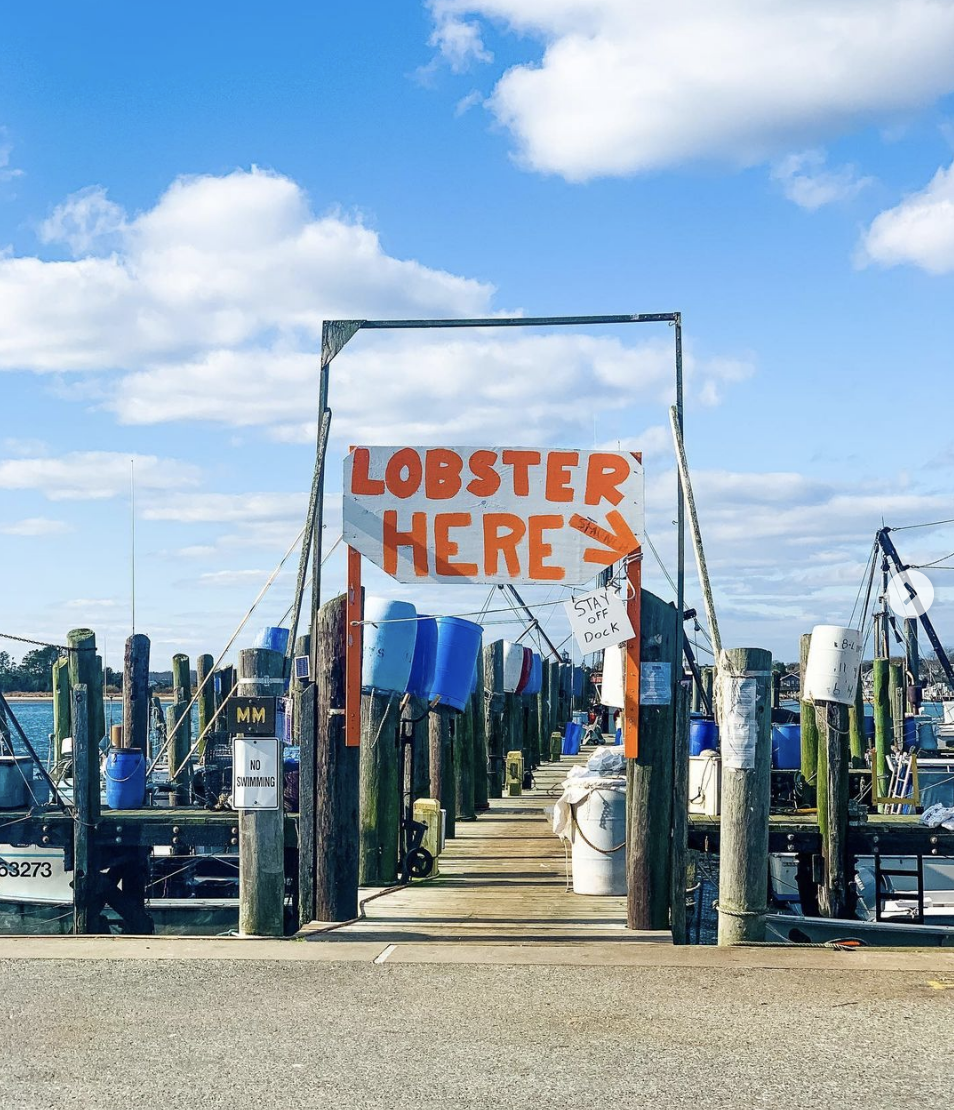
We feel unfairly blamed a lot of times.
According to Morin, the majority of the lines that are pulled off entangled whales are of unknown origin. “There are just a lot of cases [where] we don’t know what the gear is,” he says, pointing to the fact that only one third of deceased whales are ever recovered, or only a photograph or video can be retrieved to identify gear.
And with an average of five right whale cases observed annually, researchers have too small a sample size to clearly discern which gear is causing the most damage or where it came from. Many advocates argue that there isn’t enough evidence to place all of the blame on the U.S. lobster industry when there are reported impacts from shipping, entanglements in Canadian fishing gear, and natural mortality. While Morin agrees that ship strikes are also part of the issue, he says he can’t remember the last time a mature right whale died of old age.
“[Right whales] don’t appear to die of natural causes. They don’t live to their full potential because of ship strikes and entanglements.”
Another issue, says Mataronas, is the development of offshore wind.
“The Vineyard Wind I project was just approved for Level B harassment of North Atlantic right whales, and that’s any modification to their behavior,” he says. “These industries are essentially getting free passes … If that’s not hypocritical, I don’t know what is.”
Mataronas is referring to NMFS “incidental harassment authorization” for the Vineyard Wind I offshore wind farm development that allows pile driving and other activities that disturb, but not seriously injure or kill, protected marine mammals. The additional stresses from noise from construction and greater risk of ship strikes are concerns that regulators are still trying to figure out how to manage.
“Each wind turbine area might have as many as 50 vessels doing maintenance on it in some spots. That is a new stress that is coming, and we’re going to have to manage [that] along with these other threats,” says Sean Hayes, protected species branch chief for NOAA’s Northeast Fisheries Science Center, in a recent article published by the University of Washington.
COSTS
The proposed solutions to entanglement come at a hefty cost to the fishing industry.
“We feel unfairly blamed a lot of times,” says Mataronas, explaining that while he feels that the media have portrayed fishermen in the trap/pot and gillnet fisheries as obstructionists to saving an endangered species, “everyone is making an effort [to protect these whales], sacrificing both financially and timewise. Modifying gear is all additional work and money, and additional time away from the family. It’s tough on a personal level and then you get villainized [for not doing enough],” he says.
Mataronas, along with Kenney, are two of 60 members of NMFS’s Atlantic Large Whale Take Reduction Team, which is composed of fishermen, scientists, conservationists, and state and federal officials from Maine to Florida. They helped NMFS develop a plan to reduce the level of serious injury and mortality of large whales in commercial gillnet and trap/pot fisheries. But not everyone is satisfied with the outcome.
“It’s not easy having everyone reach consensus, and what we do [as regulators] is to try and have balance on all sides,” says Marisa Trego, a mammal biologist with noaa and the Atlantic Large Whale Take Reduction Team coordinator. “Some people are unhappy with the economics, even though we tried to strike a balance, and some people are unhappy with the conservation. It’s really hard to walk that fine line.”
For Mataronas, while the regulatory process can be frustrating, he appreciates that it is inclusive of all stakeholders. “There are times when it’s frustrating; you feel like you’re not being heard or [are being] pushed aside. But deep down, I feel like it’s worth it.”
Still, Mataronas feels that the socioeconomic impacts of the new regulations on fishermen have not been adequately taken into account. He adds that new rules changing the configuration of the weak ropes that are intended to break if a whale becomes entangled in them may be less effective in protecting whales while collectively costing fishermen millions of dollars.
Since 2008, Mataronas says, inshore fishermen have been using rope with weak links at the buoys with a maximum breaking strength of 600 pounds. If a whale became entangled, the line would break and drop to the seafloor while the buoy floated for recovery later. Now, the requirements place weak links at every 60 feet of rope instead of at the buoy, but have strengthened them, making them harder to break.
“I cannot think of a more harmful thing to do to a right whale than to remove possibly one of the most effective things we’ve had,” he says, explaining that while data show that adult right whales can break the new rope, freeing themselves, that may not be the case for smaller whales, such as juvenile right whales or even humpback and fin whales.
NOAA estimates that these new regulations, overall, may cost lobster and Jonah crab fishermen between $9 million to $20 million in added costs and lost revenues for the first year. Lobstermen have also been encouraged to use ropeless gear.
“Getting the rope out of the water is the only way to stop these entanglements,” says Moore, who is currently working with engineers and fishermen to improve the technology. “But the biggest challenge is affordability.”
Ropeless gear currently costs about $4,000 per trap, while a traditional trap is usually $80 to $180. This technology uses GPS and acoustic signals that can deploy a rope on demand for retrieval instead of using a fixed fishing line that hangs between a buoy on the surface and a lobster trap below.
Mataronas doesn’t think that the technology will work in the conditions he and other lobstermen fish in, and that the risk of malfunction increases the chances for undesirable gear interactions with other lobster boats and draggers.
Morin acknowledges these challenges. “We are asking the fishing industry to do a lot. There is a lot of out-of-pocket expense on their end, and I don’t think that’s fair,” he says.
“It’s a very difficult position that everyone is in, frankly. A critically endangered species that is tanking and a massive industry that tens of thousands of people rely on … it’s an incredibly complex and difficult problem that doesn’t have the level of resources to solve it,” he adds. “We’re doing the best we can with what we’ve got, and time is not on our side for the fishermen or for the whales.”
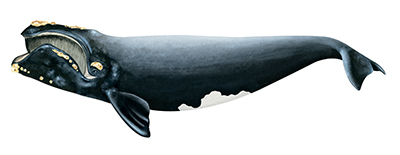
GARDENERS OF THE SEA
Whales are often referred to as gardeners of the sea for their ability to fertilize ocean waters both at the surface and in deep water across thousands of miles, fueling phytoplankton production and pulling carbon from the atmosphere and sequestering it into the deep ocean in what is referred to as the “whale pump.”
With high metabolic demands and large populations before industrial whaling, scientists say right whales had a strong influence on marine environments. If right whales disappeared tomorrow, there are ecosystem services lost we may never realize, says Moore.
“Obviously right whales today have a relatively minor role in those services because of their low numbers, but it’s not their fault,” he says. “We don’t know what we’re missing because they’ve been gone for so long, but that doesn’t mean we should have the arrogance to say that [their extinction isn’t going to be a problem].”
Recovery for many whale species is underway and is still possible for the North Atlantic right whale, which could help buffer marine ecosystems from destabilizing stresses and support more robust fisheries where whales aggregate to feed and calve, according to a publication in the journal Frontiers in Ecology and the Environment.
Contact Us
Telephone: (401) 874-6805
Email: allard@uri.edu
Contributor Guidelines
Please review submission guidelines to be considered. d

